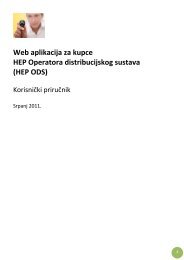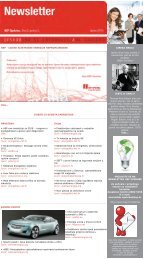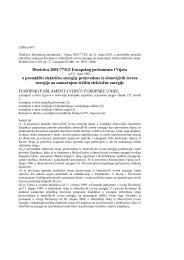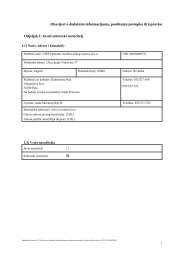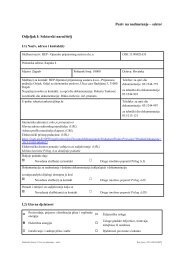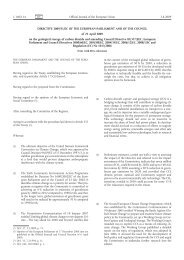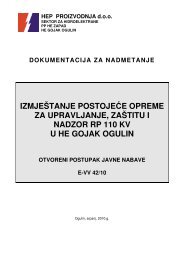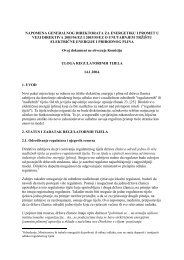DRAVA, KUPA, RJE»INA, LOKVARKA, LI»ANKA LIKA, DOBRA ...
DRAVA, KUPA, RJE»INA, LOKVARKA, LI»ANKA LIKA, DOBRA ...
DRAVA, KUPA, RJE»INA, LOKVARKA, LI»ANKA LIKA, DOBRA ...
You also want an ePaper? Increase the reach of your titles
YUMPU automatically turns print PDFs into web optimized ePapers that Google loves.
NOTES TO THE CONSOLIDATED FINANCIAL<br />
STATEMENTS OF THE HEP GROUP (CONTINUED)<br />
FOR THE YEAR ENDED 31 DECEMBER 2010<br />
2. SUMMARY OF SIGNIFICANT ACCOUNTING POLICIES (continued)<br />
PROPERTY, PLANT AND EQUIPMENT (continued)<br />
In situations where it can be clearly demonstrated that the expenditures have resulted in an increase in the<br />
future economic benefits expected to be obtained from the use of an item of property, plant and equipment beyond<br />
its originally assessed standard performance, the expenditures are capitalised as an additional cost of property,<br />
plant and equipment. Costs eligible for capitalization include costs of periodic, planned significant inspections and<br />
overhauls necessary for further operation.<br />
The gain or loss arising from disposal or withdrawal of property, plant and equipment is determined as the<br />
difference between the gains on sale and the carrying amount of the asset and are credited and charged, respectively,<br />
to the income statement.<br />
Impairment of tangible and intangible assets<br />
Items of tangible and intangible assets are reviewed for impairment whenever events or changes in circumstances<br />
indicate that the carrying amount of an asset may not be recoverable. Whenever the carrying amount of an asset<br />
exceeds its recoverable amount, an impairment loss is charged to the income statement.<br />
At each reporting date, the Group reviews the carrying amounts of its tangible and intangible assets to determine<br />
whether there is any indication that those assets have suffered an impairment loss. If any such indication<br />
exists, the recoverable amount of the asset is estimated in order to determine the extent of the impairment loss (if<br />
any). Where it is not possible to estimate the recoverable amount of an individual asset, the Group estimates the<br />
recoverable amount of the cash-generating unit to which the asset belongs.<br />
Intangible assets with indefinite useful lives and intangible assets not yet available for use are tested for<br />
impairment annually, and whenever there is an indication that the asset may be impaired.<br />
Recoverable amount is the higher of fair value less costs to sell and value in use. In assessing value in use, the<br />
estimated future cash flows are discounted to their present value using a pre-tax discount rate that reflects current<br />
market assessments of the time value of money and the risks specific to the asset.<br />
The net selling price is the amount obtainable from the sale of an asset in an arm’s length transaction less<br />
the cost of disposal, while value in use is the present value using a pre-tax discount rate that reflects current market<br />
assessments of the time value of money and the risks specific to the asset of estimated future cash flows expected<br />
to arise from the continuing use of an asset and from its disposal at the end of its useful life. Recoverable amounts<br />
are estimated for individual assets or, if it is not possible, for the relevant cash-generating unit.<br />
If the recoverable amount of an asset (or cash-generating unit) is estimated to be less than its carrying amount,<br />
the carrying amount of the asset (or cash-generating unit) is reduced to its recoverable amount. An impairment loss<br />
is recognised immediately in profit or loss, unless the relevant asset is land or a building other than an investment<br />
property carried at a revalued amount, in which case the impairment loss is treated as a revaluation decrease.<br />
Where an impairment loss subsequently reverses, the carrying amount of the asset (cash-generating unit)<br />
is increased to the revised estimate of its recoverable amount, but so that the increased carrying amount does not<br />
exceed the carrying amount that would have been determined had no impairment loss been recognised for the<br />
asset (cash-generating unit) in prior years. A reversal of an impairment loss is recognised immediately in profit or<br />
loss, unless the relevant asset is carried at a revalued amount, in which case the reversal of the impairment loss is<br />
treated as a revaluation increase.<br />
INTANGIBLE ASSETS<br />
Intangible fixed assets include patents, trademarks and licenses and are carried at cost less accumulated amortisation.<br />
Amortisation is provided on a straight-line basis over a period from 5 to 20 years.<br />
77<br />
HEP ANNUAL REPORT 2010<br />
CHAPTER 6 - FINANCIAL STATEMENTS



